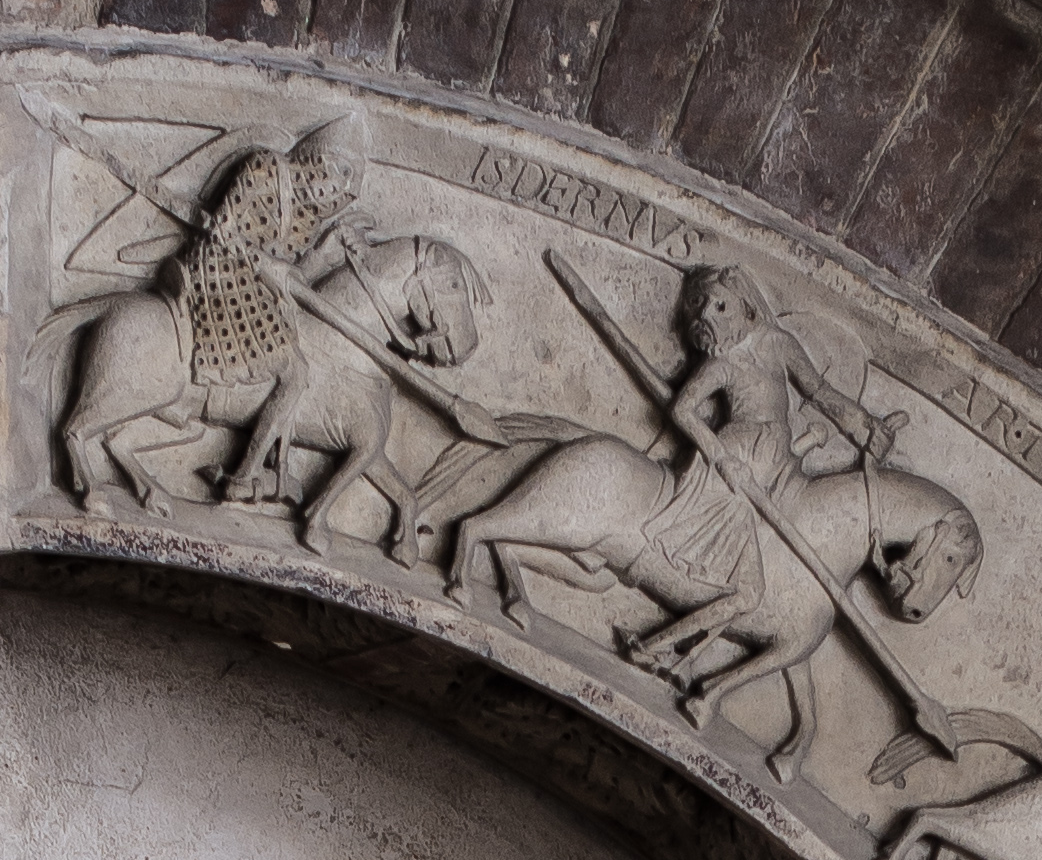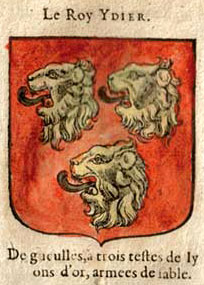Edern ap Nudd on:
[Wikipedia]
[Google]
[Amazon]
 Edern ap Nudd ( la, Hiderus; Old french: Yder or ') was a
Edern ap Nudd ( la, Hiderus; Old french: Yder or ') was a
 Outside Welsh-language writing, Edern is first seen in
Outside Welsh-language writing, Edern is first seen in
 Edern ap Nudd ( la, Hiderus; Old french: Yder or ') was a
Edern ap Nudd ( la, Hiderus; Old french: Yder or ') was a knight of the Round Table
The Knights of the Round Table ( cy, Marchogion y Ford Gron, kw, Marghekyon an Moos Krenn, br, Marc'hegien an Daol Grenn) are the knights of the fellowship of King Arthur in the literary cycle of the Matter of Britain. First appearing in lit ...
in Arthur's
Arthur's was a London gentlemen's club, now dissolved, which was established in 1811 and was disbanded in 1940. Between 1827 and 1940 it was based at 69 St James's Street. It is now best remembered for having built the London clubhouse currentl ...
court in early Arthurian tradition. As the son of Nudd (the ''Nu'', ''Nut'' or ''Nuc'' of Old French, Arthurian romance
The Matter of Britain is the body of medieval literature and legendary material associated with Great Britain and Brittany and the legendary kings and heroes associated with it, particularly King Arthur. It was one of the three great Western ...
), he is the brother of Gwyn
Gwyn or Gwynn may refer to:
People
* Gwyn (name), includes a list of people with the given name or surname Gwyn, including variants such as Gwynn and Gwynne
Fictional or mythological characters
* Gwyn ap Nudd, in Welsh mythology
* Gwynn (Sluggy F ...
, Creiddylad
Creiddylad (also known as ''Creirddylad'', ''Creurdilad'', ''Creudylad'' or ''Kreiddylat''), daughter of King Lludd, is a minor character in the early medieval Welsh Arthurian tale ''Culhwch ac Olwen''.
Role in Welsh tradition
Creiddylad, dau ...
, and Owain ap Nudd. In French romances, he is sometimes made the king of a separate realm. As St Edern, he has two churches dedicated to him in Wales.
Etymology
TheWelsh
Welsh may refer to:
Related to Wales
* Welsh, referring or related to Wales
* Welsh language, a Brittonic Celtic language spoken in Wales
* Welsh people
People
* Welsh (surname)
* Sometimes used as a synonym for the ancient Britons (Celtic peop ...
name Edern comes from a Brittonic
Brittonic or Brythonic may refer to:
*Common Brittonic, or Brythonic, the Celtic language anciently spoken in Great Britain
*Brittonic languages, a branch of the Celtic languages descended from Common Brittonic
*Britons (Celtic people)
The Br ...
borrowing of Latin ''Aeternus'', meaning "eternal, everlasting, immortal".
Appearances
In ''Culhwch ac Olwen
''Culhwch and Olwen'' ( cy, Culhwch ac Olwen) is a Welsh tale that survives in only two manuscripts about a hero connected with Arthur and his warriors: a complete version in the Red Book of Hergest, c. 1400, and a fragmented version in the Whit ...
'', Edern is named as one of Arthur's knights in a list of his retinue, but plays no part in the narrative. Edern also appears in ''The Dream of Rhonabwy
''The Dream of Rhonabwy'' ( cy, Breuddwyd Rhonabwy) is a Middle Welsh prose tale. Set during the reign of Madog ap Maredudd, prince of Powys (died 1160), its composition is typically dated to somewhere between the late 12th through the late 14th c ...
'' (a late medieval Welsh Arthurian romance) in which he commands a "pure black troop" of Danish soldiers allied to Arthur against the Saxons
The Saxons ( la, Saxones, german: Sachsen, ang, Seaxan, osx, Sahson, nds, Sassen, nl, Saksen) were a group of Germanic
*
*
*
*
peoples whose name was given in the early Middle Ages to a large country (Old Saxony, la, Saxonia) near the Nor ...
. He is named one of Arthur's foremost counsellors during the battle.
''Geraint son of Erbin''
Edern plays a more important role in ''Geraint son of Erbin'' (a Welsh adaptation of Chrétien de Troyes' romance ''Erec et Enide
, original_title_lang = fro
, translator =
, written = c. 1170
, country =
, language = Old French
, subject = Arthurian legend
, genre = Chivalric romance
, form ...
''), in which he and two companions, a beautiful lady and a whip-brandishing dwarf, come across Gwenhwyfar
Guinevere ( ; cy, Gwenhwyfar ; br, Gwenivar, kw, Gwynnever), also often written in Modern English as Guenevere or Guenever, was, according to Arthurian legend, an early-medieval queen of Great Britain and the wife of King Arthur. First ment ...
, one of her handmaidens and the knight Geraint ab Erbin in a forest. The handmaiden is sent to discover Edern's identity, but is rebuked and struck by the dwarf. Geraint also goes and suffers the same fate, but chooses to spare the dwarf's life and retreats.
Seeking his adversary, Geraint heads to a "walled town", where a great tournament is annually held. Edern, champion of the tournament for two years running, challenges Geraint to joust
Jousting is a martial game or hastilude between two horse riders wielding lances with blunted tips, often as part of a tournament. The primary aim was to replicate a clash of heavy cavalry, with each participant trying to strike the opponen ...
. Initially, Edern has the upper hand but by the end of the duel, he suffers vicious wounds at Geraint's hand and begs for mercy. Geraint allows Edern to keep his life on the condition that he rides to Arthur's court to make amends for his insult. Edern accepts the condition, and reveals his name to his rival. Edern later rides to Arthur's court where his apology is accepted by Gwenhwyfar. Heavily injured, he is treated by Morgan Tud
Morgan le Fay (, meaning 'Morgan the Fairy'), alternatively known as Morgan ''n''a, Morgain ''a/e Morg ''a''ne, Morgant ''e Morge ''i''n, and Morgue ''inamong other names and spellings ( cy, Morgên y Dylwythen Deg, kw, Morgen an Spyrys), is a ...
, the chief physician of the court. Upon his recovery, he is chosen to accompany Geraint to the kingdom of Geraint's father, Erbin.
Appearances as Yder
 Outside Welsh-language writing, Edern is first seen in
Outside Welsh-language writing, Edern is first seen in Geoffrey of Monmouth
Geoffrey of Monmouth ( la, Galfridus Monemutensis, Galfridus Arturus, cy, Gruffudd ap Arthur, Sieffre o Fynwy; 1095 – 1155) was a British cleric from Monmouth, Wales and one of the major figures in the development of British historiograph ...
's Historia Regum Britanniae
''Historia regum Britanniae'' (''The History of the Kings of Britain''), originally called ''De gestis Britonum'' (''On the Deeds of the Britons''), is a pseudohistorical account of British history, written around 1136 by Geoffrey of Monmouth. I ...
as ''Hiderus filius Nu'', a knight of King Arthur's who fought in his Gallic campaign. The poet Wace
Wace ( 1110 – after 1174), sometimes referred to as Robert Wace, was a Medieval Norman poet, who was born in Jersey and brought up in mainland Normandy (he tells us in the ''Roman de Rou'' that he was taken as a child to Caen), ending his car ...
, in his adaptation of the ''Historia Regum Britanniae'' called the ''Roman de Brut
The ''Brut'' or ''Roman de Brut'' (completed 1155) by the poet Wace is a loose and expanded translation in almost 15,000 lines of Norman-French verse of Geoffrey of Monmouth's Latin '' History of the Kings of Britain''. It was formerly known ...
'', renders the name as ''Yder fils Nu(t)''. There is also an Anglo-Norman ''Romanz du reis Yder
The ''Romanz du reis Yder'' (''Romance of King Yder'') is a medieval Anglo-Norman Arthurian romance, of which 6,769 octosyllablic verse lines survive. It was characterised in 1946 as 'equal in merit to some of Chrétien's best work, and deserves ...
''. However, Yder's "fame was too small to inspire later writers or visual artists. The only time he may have been immortalised is on the famous archivolt (1120-40) at Modena
Modena (, , ; egl, label=Emilian language#Dialects, Modenese, Mòdna ; ett, Mutna; la, Mutina) is a city and ''comune'' (municipality) on the south side of the Po Valley, in the Province of Modena in the Emilia-Romagna region of northern I ...
, which shows a knight called Idernus in a scene with King Arthur (Artus de Bretania), the captive queen Guinloie or Guenevere (Winlogee) and possibly Durmart (Burmaltus)."
Saint
Edern is the patron saint of two churches in Wales: St Edern's Church, Bodedern, in Anglesey, and the church in the village ofEdern, Gwynedd
Edern, formerly known as ''Edeyrn'', is a village and until 1939 a civil parish, in the Welsh county of Gwynedd. It is about 1 km southwest of the larger village of Morfa Nefyn, near Caernarfon Bay on the north coast of the Llŷn Peninsu ...
.
References
{{DEFAULTSORT:EDERN, AP NUDD Arthurian characters Welsh mythology